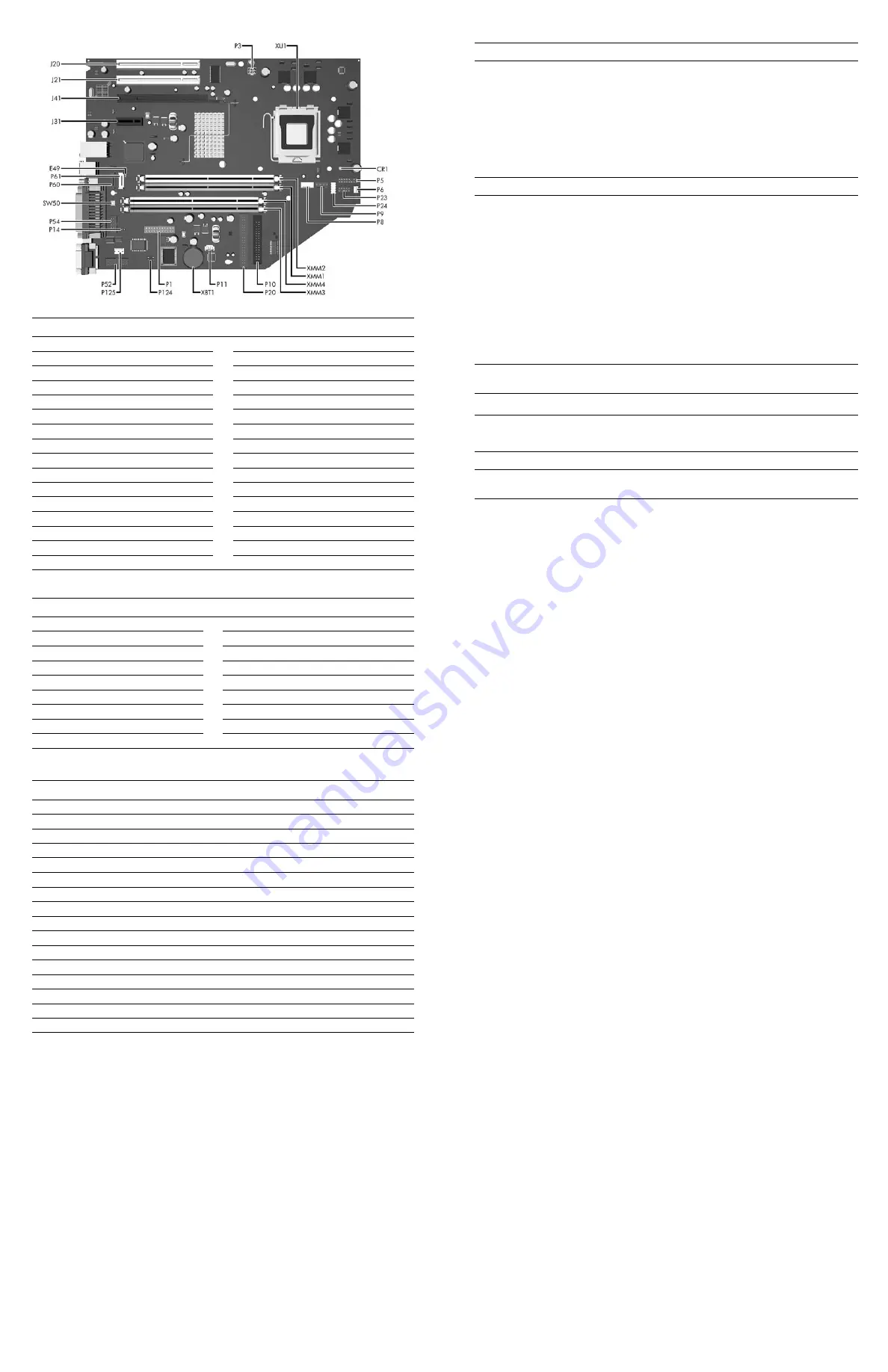
System Board Connectors and Jumpers (position of some untitled components may vary in location)
CR1
5V Aux power LED
P23
Front audio
E49
Password jumper
P24
USB connector, front panel
J20
PCI slot 1
P52
Second Serial port
J21
PCI slot 2
P54
Primary Serial port
J31
PCI Express x1
P60
Primary Serial ATA (SATA) connector
J41
PCI Express x16
P61
Secondary Serial ATA (SATA) connector
P1
Main power (24 pin)
P124
Hood lock
P3
Processor 12V header
P125
Hood sensor
P5
Main power switch/LED
SW50
CMOS button
P6
Internal chassis speaker
XBT1
Battery
P8
Primary chassis fan
XMM1
Memory socket
P9
Secondary chassis fan
XMM2
Memory socket
P10
Diskette drive
XMM3
Memory socket
P11
Aux audio in
XMM4
Memory socket
P14
Boot block
XU1
Microprocessor socket
P20
IDE
System Hardware Interrupts
IRQ
System Function
IRQ
System Function
0
Timer Interrupt
8
Real-Time Clock
1
Keyboard
9
Unused
2
Interrupt Controller Cascade
10
Unused, available for PCI
3
Serial Port (COM B)
11
Unused, available for PCI
4
Serial Port (COM A)
12
Mouse
5
Unused, available for PCI
13
Coprocessor
6
Diskette Drive
14
Primary ATA (IDE) Controller
7
Parallel Port (LPT 1)
Computer Diagnostic LEDs (on front of computer)
LED
Color
LED/Beep Activity
State/Message
Power
Green
On
(S0) Computer on
Power
Green
1 blink every 2 seconds
(S1) Suspend Mode
Power
Green
1 blink every 2 seconds
(S3) Suspend to RAM
Power
Clear
Off
(S4) Hibernation
Power
Clear
Off
(S5) Computer off
Power
Red*
2 blinks 1 second apart
CPU thermal shutdown
Power
Red*
3 blinks 1 second apart
CPU not installed
Power
Red*
4 blinks 1 second apart
Power supply overload (crow bar)
Power
Red*
5 blinks 1 second apart
Defective or missing memory
Power
Red*
6 blinks 1 second apart
Defective or missing graphics
Power
Red*
7 blinks 1 second apart
System board failure (detected prior to video)
Power
Red*
8 blinks 1 second apart
Invalid ROM based on checksum
Power
Red*
9 blinks 1 second apart
System not fetching code
Power
Red*
10 blinks 1 second apart
System hang while loading an option ROM
Hard Drive
Green
Blinking
Hard drive activity
*
Blinking codes are repeated after a 2 second pause. Beeps stop after fifth iteration but LEDs continue until problem is
resolved.
Clearing CMOS
The computer's configuration (CMOS) may occasionally be corrupted. If it is, it is necessary to clear the CMOS
memory using switch SW50.
To clear and reset the configuration, perform the following procedure:
1.
Turn off the computer and any external devices, and disconnect the power cord from the power outlet.
Ä
CAUTION:
You must disconnect the power cord from the power source before pushing the Clear CMOS
Button (NOTE: All LEDs on the board should be OFF). Failure to do so may damage the system board.
2.
Remove the access panel.
3.
Press the CMOS button located on the system board.
4.
Replace the access panel.
5.
Turn the computer on and run F10 Computer Setup (Setup utility) to reconfigure the system.
Disabling or Clearing the Power-On and Setup Passwords
1.
Turn off the computer and any external devices, and disconnect the power cord from the power outlet.
2.
Remove the access panel.
3.
Locate the header and jumper labeled E49.
4.
Remove the jumper from pins 1 and 2. Place the jumper over pin 2 only to avoid losing it.
5.
Replace the access panel.
6.
Plug in the computer and turn on power. Allow the operating system to start.
NOTE: Placing the jumper on pin 2 clears the current passwords and disables the password features.
7.
To re-enable the password features, repeat steps 1-3, then replace the jumper on pins 1 and 2.
8.
Repeat steps 5-6, then establish new passwords.
Refer to the
Desktop Management Guide
and the
Computer Setup (F10) Utility Guide
for instructions on
establishing new passwords
Computer Setup (F10) Utility Features (not all features may be available)
File
System Information
About
Set Time and date
Flash system ROM
Replicated Setup
Default Setup
Apply Defaults and Exit
Ignore Changes and Exit
Save Changes and Exit
Storage
Device Configuration
Storage Options
DPS Self-Test
Boot Order
Security
Smart Card Options
Setup Password
Power-On Password
Password Options
Smart Cover
Embedded Security
Device Security
Network Service Boot
System IDs
Drivelock Security
OS Security
Data Execution Prevention
Power
OS Power Management
Hardware Power Management
Thermal
Advanced
Power-On Options
Execute Memory Test
BIOS Power On
Onboard Devices
PCI Devices
PCI VGA Configuration
Bus Options
Device Options
Note: See the Computer Setup (F10) Utility Guide on the Documentation and Diagnostics CD.


